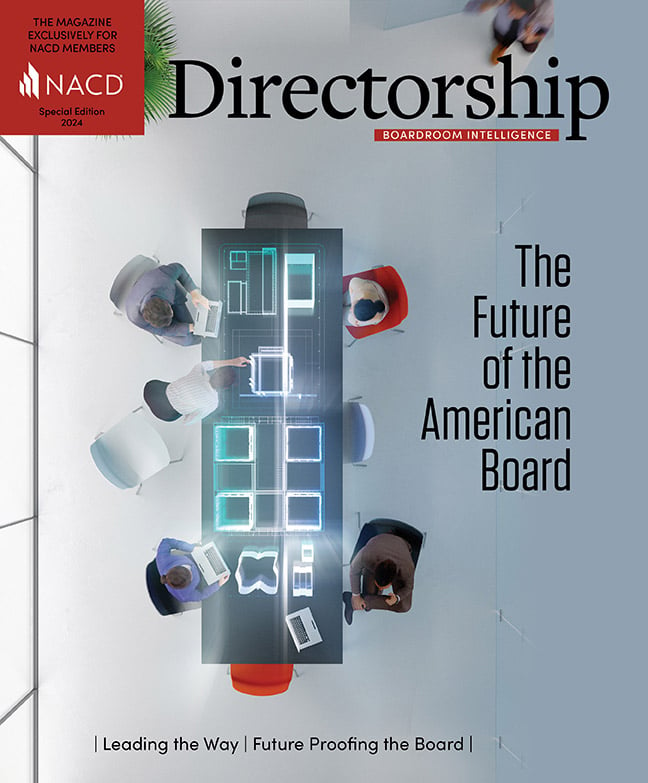Feedback from directors, from both public and private companies alike, on the 10 principles outlined in the Future of the American Board report has been positive: comments include “thought provoking” and that it is a “useful framework.” From my perspective, the report is missing one critical element: How can the 10 principles be incorporated into board operations and culture to help our boards become even higher performing? Let me address that missing piece in this article.
As one of the commissioners who helped to craft this timely report, I’ve had the opportunity to make recommendations to public and private company boards on how to use and implement the principles in the Future of the American Board to become more effective and future ready.
The 10 principles are quite extensive, covering everything from corporate purpose to board agendas to compensation and talent. Consequently, using them to drive board performance requires a practical, focused approach.
Here’s my five-step approach on how to use the principles to strengthen board performance:
-
Select and obtain agreement with board colleagues on two to three principles for board focus.
-
Determine the impact of each principle on both board and company culture and operations using questions posed in the report at the end of each principle.
-
Develop an action plan for how to use the selected principles to drive board performance.
-
Identify key performance indicators (KPIs) to monitor and track the success of this action plan.
-
Monitor and adapt the action plan for success, as needed.
Theory is helpful, but let’s put it into practice. Imagine you’re the chair of Company ZZZ. This global multichannel retailer targets Generation Z and younger millennials. As chair, your objective is to lead the board on a journey of higher performance, using the Future of the American Board principles as a tool.
Step 1: Focus on a Few Principles
For example, as chair, you decide to begin with two principles: Principle One: Corporate Purpose and Principle Seven: Talent & Compensation. Then to gain agreement from all board members, you lead a discussion on the selection of these principles. Get the perspectives of each board member.
-
Are these the best two principles to focus on now, given Company ZZZ strategy, markets, operational challenges, and competitors?
-
How will you measure the impact of your efforts to take the board into the future and increase effectiveness?
Company ZZZ first selection: Principle One. Corporate purpose is the foundation of what we do as board members and executives. In reality, the other principles don’t matter unless the board, executives, management, and employees are clear and committed to the purpose of the corporation.
In preparing the report, the commissioners had a wide range of viewpoints on the value of corporate purpose in today’s world. In several discussions, the Future of the American Board commissioners even went back to business school and Peter Drucker’s definition of a corporation. We debated the relevancy of this definition and decided it is still relevant, provided boards consider a few additional questions. For example, how can or should a company balance the needs of the community and shareholder value? Or, even more basic, should a corporation be concerned about anything beyond driving shareholder value? Certainly, every company needs to consider several constituencies—shareholders, consumers or customers, and employees—otherwise, purpose won’t be achieved, and the company can’t thrive.
Company ZZZ second selection: Principle Seven. The most significant new element of this principle is well-being. Ten or even five years ago, employee well-being was not a boardroom or management topic. Interestingly, well-being is also the most difficult to define. It’s not easy to understand its role in the purpose or mission of a company. How can the board best support and inspect human capital strategies that improve employee well-being as well as approve great strategies that drive more traditional human capital objectives to attract, retain, develop, and compensate superb people?
Our theoretical organization, Company ZZZ, employs all types of people, but has a large percentage of teenage employees. Understanding their worlds is critical. What if one of your teenaged employees is being bullied? How does the board think about and provide management with good guidance related to employee well-being? What do your managers and executives do to put themselves in your employees’ shoes and help their well-being?
Step 2: Lead a Robust Board Discussion
Understand how these two principles can impact board culture and performance, company strategy, company culture, and company performance. Use the questions at the end of each principle in the Future of the American Board report to help structure this discussion.
As part of developing Company ZZZ’s action plan, your board needs to address two critical questions posed at the end of Principle One:
-
What additional constituencies, if any, should be considered in discussions about corporate purpose? (I serve as an independent director on several family-held fiduciary boards. Voting shareholders are obviously key. But what about previous shareholders or next-generation, soon-to-be shareholders?)
-
What are the anticipated net benefits and negative impacts of determining and establishing the company’s corporate purpose? Helping management see around corners is an important board responsibility.
As for Principle Seven, the Company ZZZ board can start the discussion by asking and answering the following questions from the report:
Do workforce issues receive appropriate focus from the board (or a board committee), and does the board review unfiltered information about workforce satisfaction and engagement?
How does the board support the development of the company’s next leaders and its employees?
Step 3: Develop an Action Plan
Now that you’ve selected the principles to focus on and have discussed and understand potential impacts and risks, what is needed to drive further board performance?
The board may wish to focus on a few key improvement targets. In the case of Company ZZZ, your board may determine that the business needs to be more transparent about its purpose, values, and culture so that management and the workforce understand policies that define appropriate workplace conduct and the mission that drives the business. One option is for the board to support management in crafting a statement of purpose from which the corporate strategy and culture framework will follow.
Step 4: Determine KPIs
As part of the action plan, what does success look like? How do the CEO and the C-suite define success? Are definitions of success consistent between the board and management team? If not, what will you as chair do to ensure the success of using the Future of the American Board principles to drive high performance?
Regarding Principle Seven, the Company ZZZ board may determine that it needs better insight into workforce satisfaction metrics. Many boards request results of monthly two question “pulse” surveys that supplement annual employee engagement surveys. Management can share with the board plans to address opportunities identified by these engagement surveys.
Step 5: Monitor and Adapt
Finally, how do you ensure that these principles are core to the board’s work? Who owns monitoring KPIs and adjusting the plan as needed? Every board has its own approach. Some incorporate actions into committees. Others will identify a few members and create a limited-time task force to help management.
If employees feel disconnected from Company ZZZ’s stated purpose or feel that it is disingenuous, or report that corporate culture has worsened, your board should be asking management why. Has management aligned strategy, policies, and company-wide goals to corporate purpose? On the positive side, if employee engagement has increased, the board can help management to understand and learn what is driving positive results so future improvements build on these impactful learnings.
My examples and descriptions are only one approach to how a board can use the Future of the American Board framework. Please remember, the committee purposefully structured the report to not be prescriptive. It is not a checklist. It is not a report filled with easy answers. It is a framework of thinking that can help lead to further strengthening a board’s impact. ■
This article is from the Directorship Special Issue 2024: The Future of the American Board.




